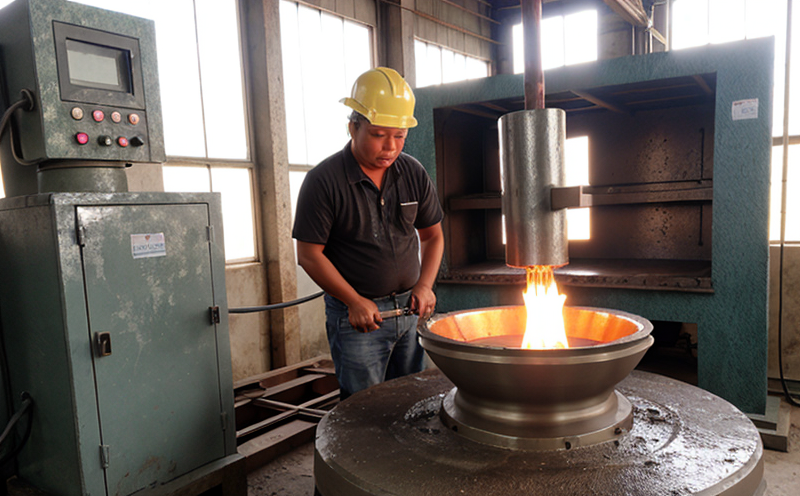ISO 8087 Creep Testing of Cast Components
The ISO 8087 standard specifies the procedure for determining the creep properties of cast components. This is crucial in ensuring that materials used in high-temperature applications, such as those found in industrial manufacturing and processing testing, are suitable for their intended use. Creep testing helps predict the long-term behavior of materials under stress, which is essential to avoid failures due to prolonged exposure to high temperatures.
Casting and foundry processes play a critical role in the production of components used across various industries. The integrity of these cast parts can be significantly influenced by the creep properties of the material used. This testing ensures that the materials can withstand the expected stresses over time, preventing potential failures in service. The test is particularly important for applications where continuous operation at elevated temperatures is required, such as in power generation, petrochemical processing, and aerospace industries.
The procedure involves subjecting a specimen to a constant stress at a specified temperature for an extended period of time. The deformation or elongation caused by the applied load is measured over this duration. This data helps determine the creep rate and ultimately assesses the material's suitability for use in high-temperature environments. Compliance with ISO 8087 is essential for ensuring that materials meet quality standards and are reliable under operational conditions.
At our laboratory, we perform this test meticulously using state-of-the-art equipment to ensure accuracy and reliability. Our team of experts adheres strictly to the ISO 8087 standard to deliver precise results. The test parameters can vary based on the specific requirements of the component being tested. For instance, the temperature range might be set from 250°C to 900°C depending on the application, and the time duration could range from a few hours up to several days.
Specimen preparation is critical for accurate creep testing results. The specimen must be carefully machined to the required dimensions and orientation to ensure that it accurately represents the expected in-service conditions. The surface finish should also meet precise standards to avoid any extraneous factors influencing the test outcome.
| Parameter | Description |
|---|---|
| Temperature Range | 250°C to 900°C, depending on the application. |
| Time Duration | From a few hours up to several days. |
| Stress Level | Determined by the expected operational conditions. |
The instrumentation used in this testing is sophisticated, incorporating advanced sensors and data acquisition systems to monitor the deformation of the specimen accurately. The results are then analyzed according to ISO 8087 guidelines to produce a comprehensive report detailing the creep behavior of the material.
- High-temperature resistance
- Precision in stress measurement
- Consistency in temperature control
- Reliable data acquisition and analysis
This testing is not only essential for quality assurance but also for continuous improvement. By understanding the creep behavior of materials, manufacturers can optimize their processes to produce more durable and reliable cast components.
Why It Matters
The integrity of cast components in high-temperature applications is paramount for operational safety and efficiency. Creep testing ensures that the materials used are capable of withstanding the stresses they will encounter over their lifetime. This test provides critical insights into material behavior under sustained stress, which is vital for preventing catastrophic failures.
For instance, in power generation equipment, where continuous operation at high temperatures is necessary, creep testing helps identify potential weaknesses that could lead to premature failure or even complete system shutdown. In petrochemical processing facilities, the use of materials that can withstand extreme conditions ensures optimal performance and reduces maintenance downtime. In aerospace applications, reliability is critical, and creep testing plays a crucial role in ensuring that components remain functional over their lifespan.
The results of this test are also valuable for regulatory compliance. Many industries have strict standards and regulations governing the use of materials in high-temperature environments. Compliance with ISO 8087 ensures that products meet these requirements, thereby reducing the risk of non-compliance penalties and enhancing the reputation of manufacturers.
Customer Impact and Satisfaction
The impact of creep testing on customer satisfaction is significant. By ensuring that cast components are reliable and durable, customers can expect higher quality products that meet stringent performance standards. This leads to increased customer confidence in the reliability of the materials used.
For manufacturers, compliance with ISO 8087 not only enhances product quality but also reduces the risk of costly failures and recalls. It demonstrates a commitment to excellence and builds trust with customers and regulatory bodies. In turn, this can lead to improved customer satisfaction and loyalty.
The results of creep testing are often shared with clients, providing them with valuable insights into material performance. This transparency fosters better communication between the laboratory and its customers, ensuring that any necessary adjustments or improvements are made promptly.
Use Cases and Application Examples
- Power generation equipment for steam turbines
- Petrochemical processing units with high-temperature reactors
- Aerospace components such as jet engine parts
- Turbine blades in gas turbines
| Component Type | Description | Temperature Range | Critical Factors |
|---|---|---|---|
| Turbine Blades | High-temperature resistance and durability | 400°C to 800°C | Thermal stress, corrosion resistance |
| Steam Turbine Components | Efficiency under high thermal loads | 250°C to 600°C | Temperature stability, material fatigue |
| Petrochemical Reactors | Corrosion resistance and durability | 300°C to 750°C | Thermal expansion, chemical stability |
The results of creep testing are essential for optimizing the design and manufacturing processes of these components. By understanding how materials behave under specific conditions, engineers can make informed decisions that enhance product performance and reliability.





